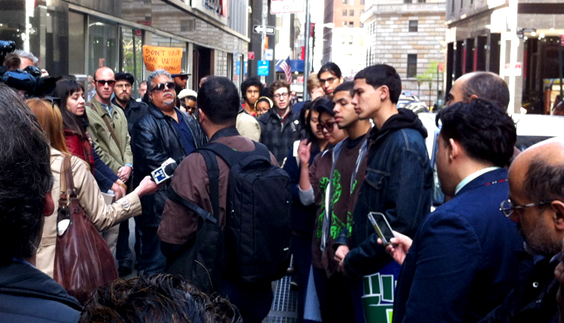
Brooklyn Alliance for Sustainable Energy
Projections show that within the next 10 years, Con Edison will not have the capacity to meet the peak energy needs for all of Brooklyn. Energy usage in Brooklyn is growing, and projections show that within the next 10 years, Con Edison’s Brownsville 2.0 substation will not have the capacity to meet the peak energy needs for communities in Bushwick, Bedford Stuyvesant, East New York, Cypress Hills, Crown Heights, East Flatbush, and Brownsville. Within this impacted zone, 90 percent of residents are people of color; 76 percent residents have a median household income below $30,000, and 68,880 people reside in 66 NYCHA housing developments. Increased load demand could mean losing power when we need it most, especially during heat waves when air conditioners are blasting, and after storm surges that disrupt outdated energy infrastructure.
Article X: New York State’s Power Plant Siting Law
In 2011, NYC-EJA was invited by Governor Cuomo’s Office and the NYS Assembly to provide advice for the re-authorization of Article X (New York State’s power plant siting law, which expired in 2003). Known as the Power NY Act, NYC-EJA worked with allies NY Lawyers for the Public Interest, NYPIRG, and Environmental Advocates of NY to ensure the new Article X law provided the strongest protections for environmentally overburdened communities of color. Power NY mandated (for the first time) the development of environmental impact analyses that measure a community’s total environmental load before a power plant siting can be approved. More importantly, Power NY mandated that the NYS Department of Environmental Conservation promulgate regulations for the State’s first ever “disproportionate burdens” analyses. If a community is found to be disproportionately burdened, power plant applicants will have to commit to local, verifiable offsets of any projected pollution emissions before the power plant can be sited, thereby easing the burden on our most vulnerable communities.
Brownfield Development
NYC-EJA is working with members and ally organizations on several brownfield policy initiatives, including continued implementation of the City’s Office of Environmental Remediation and proposals for state and federal collaborations.
There are numerous brownfields in New York City, with a majority located within the low-income communities of color that NYC-EJA serves. A brownfield is land previously used for industrial purposes or certain commercial uses, which may be – or perceived to be – contaminated by low concentrations of hazardous waste or pollution. The perceived or actual contamination complicates the reuse or redevelopment of a brownfield, raising possible liability concerns for developers and investors (land that is more severely contaminated and has high concentrations of hazardous waste or pollution, such as a Superfund site, does not fall under the brownfield classification.) Often the only develop-able land remaining in low-income communities, brownfields are clustered due to a history of industrial use, illegal dumping and/improper storage and handling of commercial products. Brownfields take many forms such as abandoned gas stations, vacant lots, empty manufacturing plants and auto shops. NYC-EJA and its members are involved in a range of brownfield remediation, development and advocacy efforts throughout our communities.
Charter Revision and Fair Share
In March 2010, Mayor Bloomberg appointed the NYC Charter Revision Commission to comprehensively review and recommend changes to the City Charter for voter referenda approval. A critical policy area for environmental justice advocates is the fair share provision of the Charter. Introduced during the 1989 Charter Revision, fair share was intended to prevent the precipitous siting of offensive city facilities on overburdened communities without thorough review, prior notice in a Citywide Statement of Needs and community consultation. City government subsequently gutted the fair share provisions via rule-making. In 2010, NYC-EJA successfully advocated that the Charter Revision Commission propose an amendment to include all public and private waste and transportation infrastructure facilities on the City’s “Fair Share” map. 83% of New Yorkers who voted on the November 2010 ballot questions approved this amendment.
PlaNYC 2030
NYC-EJA and its members were key stakeholders and participants in the Bloomberg Administration’s creation of PlaNYC 2030, New York City’s long-term growth and sustainability plan, which has become an international model for large cities. NYC-EJA has also worked with the City Council on several key PlaNYC initiatives, including the Greener, Greater Buildings Plan (the first comprehensive, mandatory effort by an American city to reduce emissions from existing large buildings) and congestion pricing.
Green Jobs Apprenticeship Program
In 1995, NYC-EJA created the first green jobs apprenticeship program in New York City, the Minority Workers Training Program. NYC-EJA is a co-founder of the New York City Apollo Alliance and is a partner in their living wage green jobs campaign in NYC; at the State level, NYC-EJA works with the Center for Working Families on NYS green jobs strategies.
Open Space Equity Project
NYC-EJA’s Open Space Equity Project successfully documented open space disparities for communities of color and advocated that the City create new playgrounds and waterfront parks in underserved neighborhoods.
